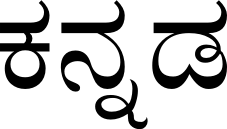Difference between revisions of "Language/Kannada/Grammar/Negation"
m (Quick edit) |
m (Quick edit) |
||
| Line 52: | Line 52: | ||
➡ If you have any questions, please ask them in the comments section below.<br>➡ Feel free to edit this wiki page if you think it can be improved. 😎 | ➡ If you have any questions, please ask them in the comments section below.<br>➡ Feel free to edit this wiki page if you think it can be improved. 😎 | ||
==Related Lessons== | |||
* [[Language/Kannada/Grammar/Conditional-Mood|Conditional Mood]] | |||
* [[Language/Kannada/Grammar/Pronouns|Pronouns]] | |||
* [[Language/Kannada/Grammar/Adjectives|Adjectives]] | |||
* [[Language/Kannada/Grammar/Gender|Gender]] | |||
* [[Language/Kannada/Grammar/Questions|Questions]] | |||
* [[Language/Kannada/Grammar/Nouns|Nouns]] | |||
* [[Language/Kannada/Grammar/Future-Tense|Future Tense]] | |||
{{Kannada-Page-Bottom}} | {{Kannada-Page-Bottom}} | ||
Revision as of 22:51, 25 February 2023
Hi Kannada learners! 😊
In this lesson, we will learn about negation in Kannada. Negation is a very important part of any language, and it is essential to understand how to use it correctly in order to communicate effectively. We will look at the different ways to express negation in Kannada, as well as some examples of how to use them.
Negation is the process of expressing the opposite of something. In Kannada, there are several ways to express negation. The most common way is to use the word ಇಲ್ಲ (illa). This word can be used to negate verbs, adjectives, nouns, and other parts of speech. For example:
- ನಾನು ಹೋದೆನು (Nānu hōdenu) - I am going
- ನಾನು ಇಲ್ಲ (Nānu illa) - I am not going
Another way to express negation in Kannada is to use the word ಅಲ್ಲ (alla). This word is used to negate verbs, adjectives, nouns, and other parts of speech. For example:
- ಅವರು ಹೋದರು (Avaru hōdarū) - They are going
- ಅವರು ಅಲ್ಲ (Avaru alla) - They are not going
The third way to express negation in Kannada is to use the word ಇಲ್ಲವೇ (illavē). This word is used to negate verbs, adjectives, nouns, and other parts of speech. For example:
- ತಮ್ಮ ಹೆಸರು ಹೊಸವಾಗಿದೆ (Tamm heṣaru hēūsavāgidē) - Your name is new
- ತಮ್ಮ ಹೆಸರು ಇಲ್ಲವೇ (Tamm heṣaru illavē) - Your name is not new
Finally, the fourth way to express negation in Kannada is to use the word ಅಲ್ಲವೇ (allavē). This word is used to negate verbs, adjectives, nouns, and other parts of speech. For example:
- ಅವರು ಕೊಂಡಿಗಳು ಹೊರತುಗಳಿದ್ದಾರೆ (Avaru koṇḍigalu hōratugalidāre) - They have changed their minds
- ಅವರು ಕೊಂಡಿಗಳು ಅಲ್ಲವೇ (Avaru koṇḍigalu allavē) - They have not changed their minds
Now that you know the different ways to express negation in Kannada, let's look at some examples of how to use them.
Examples
| Kannada | Pronunciation | English Translation |
|---|---|---|
| ನಾನು ಹೋದೆನು | Nānu hōdenu | I am going |
| ನಾನು ಇಲ್ಲ | Nānu illa | I am not going |
| ಅವರು ಹೋದರು | Avaru hōdarū | They are going |
| ಅವರು ಅಲ್ಲ | Avaru alla | They are not going |
| ತಮ್ಮ ಹೆಸರು ಹೊಸವಾಗಿದೆ | Tamm heṣaru hēūsavāgidē | Your name is new |
| ತಮ್ಮ ಹೆಸರು ಇಲ್ಲವೇ | Tamm heṣaru illavē | Your name is not new |
| ಅವರು ಕೊಂಡಿಗಳು ಹೊರತುಗಳಿದ್ದಾರೆ | Avaru koṇḍigalu hōratugalidāre | They have changed their minds |
| ಅವರು ಕೊಂಡಿಗಳು ಅಲ್ಲವೇ | Avaru koṇḍigalu allavē | They have not changed their minds |
As you can see, negation in Kannada is quite simple. You just need to remember the four words ಇಲ್ಲ (illa), ಅಲ್ಲ (alla), ಇಲ್ಲವೇ (illavē), and ಅಲ್ಲವೇ (allavē). With practice, you will be able to use these words correctly and confidently in your conversations.
➡ If you have any questions, please ask them in the comments section below.
➡ Feel free to edit this wiki page if you think it can be improved. 😎
Related Lessons
